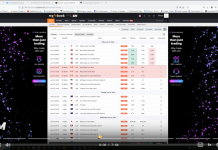As the world market continues to push forward in the wake of 2020’s economic downturn, certain commodities are looking to bounce back in the coming year. And as COVID-19 vaccinations are being rolled out and numerous industries start enacting new adaptive measures, analysts expect a continued spike in commodity prices in response to the new landscape. Despite a shakeup in supply and demand last year, 2021 will likely see prices grow towards more stabilisation by 2022.
This anticipated increase for commodities goes hand in hand with other markets that are already starting to thrive during the transition period post-COVID-19. This includes major players like biotech and surprisingly resilient industries like the S&P 500 and the Hang Seng Index.
Energy will lead the charge in commodity comebacks
 Although the sector took a beating last year, energy commodities will be spearheading the upward trend of the global market in 2021. The International Banker has reported a 6.4 percent increase in energy commodity prices, noticeably higher than non-energy commodities that still saw improvement at 4.4 percent.
Although the sector took a beating last year, energy commodities will be spearheading the upward trend of the global market in 2021. The International Banker has reported a 6.4 percent increase in energy commodity prices, noticeably higher than non-energy commodities that still saw improvement at 4.4 percent.
It is expected that throughout the year, the energy commodity sector will be seeing a 40.1 percent return. This return to form is largely being attributed to the reframed trajectory of the sector in light of the pandemic. Demand continues to grow as global players seek out renewable resources and aim to reduce their emissions.
Global oil growth will be making a noticeable recovery
Global oil prices have already jumped significantly compared to 2020’s record lows. Although they haven’t surpassed pre-pandemic numbers, oil is expected to be the outperforming commodity of the year.
 And in the past 30-days, the trading heat map on FXCM has consistently been topped by oil, particularly USOil, a CFD based on the market activity of the West Texas Intermediate (WTI) crude oil. It is followed closely by UKOil, widely representative of European, Asian, Middle Eastern and African pricing markets with Brent.
And in the past 30-days, the trading heat map on FXCM has consistently been topped by oil, particularly USOil, a CFD based on the market activity of the West Texas Intermediate (WTI) crude oil. It is followed closely by UKOil, widely representative of European, Asian, Middle Eastern and African pricing markets with Brent.
This signals WTI and Brent’s stronghold over other commodities, and shows how its liquidity is still a viable driver in the global market.
Demand will increase for soybeans, grains, and wheat
Though agricultural commodities are expected to have a slower growth this year, the biggest demand will be for soybeans, grains, and wheat. Overall gains are not expected to be particularly high or noteworthy throughout the year, but steady gains will still be par for the course.
The aforementioned agri-commodities will, however, see a noticeable price increase due to global demand for food security. This comes hot on the heels of 2020’s hoarding market behaviour, which in turn led to some turbulence in various regions. As supplies continue to pour out, this bullish run won’t likely diminish anytime soon for these particular resources.
Base metals will lead the industrial commodities sector
 Precious metals may have stabilised after seeing record highs during the height of the pandemic but this is expected to take a downturn in the year to come. Base metals, which had already seen major demand in Q4 of 2020, are expected to continue their bullish prices in 2021. This will likely be led by China, and based on data from Shanghai Chaos Investment, one of the biggest asset managers for commodities in China, copper and aluminium are among the metals to watch out for.
Precious metals may have stabilised after seeing record highs during the height of the pandemic but this is expected to take a downturn in the year to come. Base metals, which had already seen major demand in Q4 of 2020, are expected to continue their bullish prices in 2021. This will likely be led by China, and based on data from Shanghai Chaos Investment, one of the biggest asset managers for commodities in China, copper and aluminium are among the metals to watch out for.
This prediction remains despite the likes of JPMorgan closing their calls and transitioning to neutral positions on base metals such as nickel and those mentioned above. The World Bank’s outlook expects the fall of precious metal prices to be congruous with this, though still forecasting higher prices than 2019’s Q4.
Overall, commodity markets will be seeing a resurgence due to a more confident economic landscape recovering from 2020. Although stability and growth will be the main factors that investors ought to watch for, a slow and steady comeback is taking shape and should add some insight into what will likely take over portfolios this year.

















